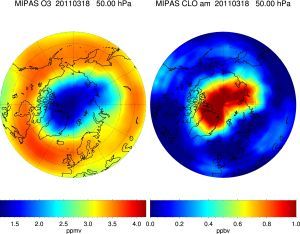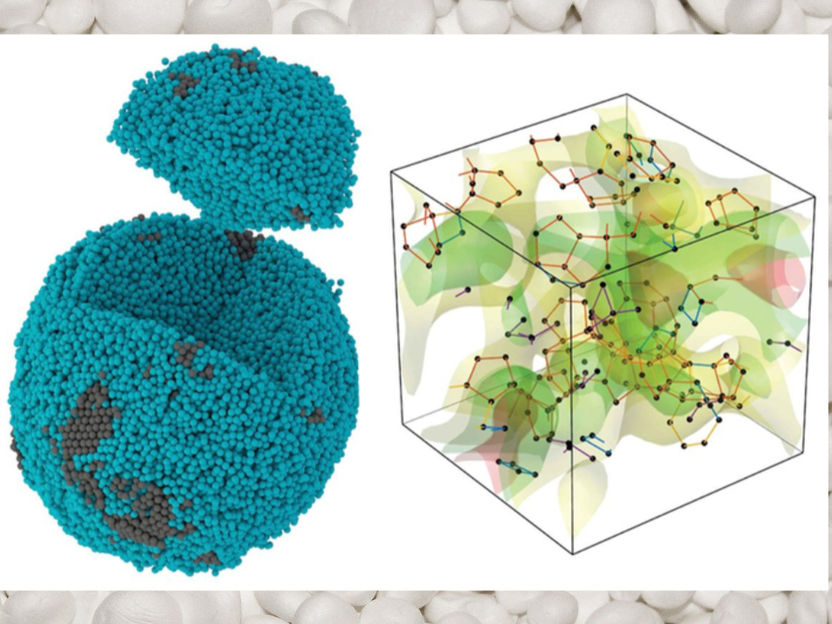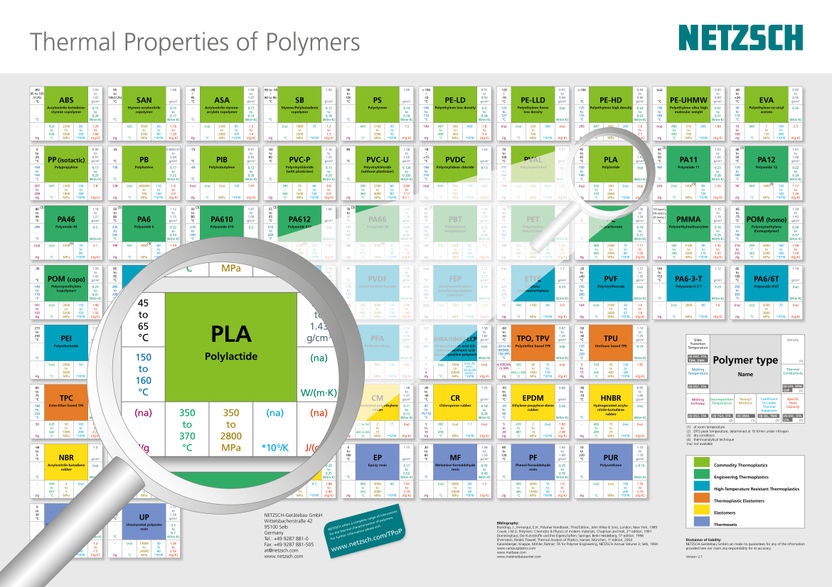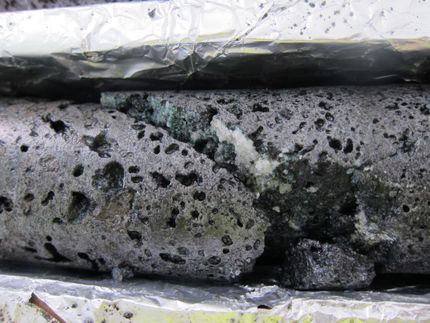Low Temperatures Enhance Ozone Degradation above the Arctic
KIT Climate Researchers Studied Ozone Hole Formation
Extraordinarily cold temperatures in the winter of 2010/2011 caused the most massive destruction of the ozone layer above the Arctic so far: The mechanisms leading to the first ozone hole above the North Pole were studied by scientists of the KIT Institute of Meteorology and Climate Research (IMK). According to these studies, further cooling of the ozone layer may enhance the influence of ozone-destroying substances, e.g. chlorofluorocarbons (CFC), such that repeated occurrence of an ozone hole above the Arctic has to be expected.

March 2011: Strongly reduced ozone values (left, dark blue) and significantly increased concentration of chlorine monoxide (right, red) that is directly involved in ozone degradation.
IMK-ASF, KIT
About a year ago, IMK scientists, together with colleagues from Oxford, detected that ozone degradation above the Arctic for the first time reached an extent comparable to that of the ozone hole above the South Pole. Then, the KIT researchers studied the mechanisms behind.
According to IMK studies, occurrence of the Arctic ozone hole was mainly due to the extraordinarily cold temperatures in the ozone layer that is located at about 18 km height in the stratosphere, i.e. the second layer of the earth’s atmosphere. There, chlorine compounds originating from chlorofluorocarbons (CFC, e.g. greenhouse gases and refrigerants) and other pollutants are converted chemically at temperatures below -78°C. These chemical conversion products attack the ozone layer and destroy it partly. One of the main statements in the study: If the trend to colder temperatures in the stratosphere observed in the past decades will continue, repeated occurrence of an Arctic ozone hole has to be expected.
The team of IMK researchers analyzed measurements of the chemical composition of the atmosphere by the MIPAS satellite instrument developed by KIT. In addition, model calculations were made to determine concrete effects of further cooling of the ozone layer. “We found that further decrease in temperature by just 1°C would be sufficient to cause a nearly complete destruction of the Arctic ozone layer in certain areas,” says Dr. Björn-Martin Sinnhuber, main author of the study. Observations over the past thirty years indicate that the stratosphere in cold Arctic winters cooled down by about 1°C per decade on the average. According to Sinnhuber, further development of the ozone layer will consequently be influenced also by climate change. He points out that the increase in carbon dioxide and other greenhouse gases will warm up the bottom air layers near the ground due to the reflection of part of the thermal radiation by the bottom layer of the atmosphere towards the earth’s surface, but also result in a cooling of the air layers of the stratosphere above, where the ozone layer is located.
After the first discovery of the Antarctic ozone hole in the mid-1980s, CFCs were rapidly identified to be the cause and their use was prohibited by the Montreal Protocol of 1987. However, it will take decades until these substances will have been removed completely from the atmosphere. “Future cooling of the stratosphere would enhance and extend the impacts of these substances on the ozone layer,” says Dr. Björn-Martin Sinnhuber. It is now necessary to study potential feedbacks on climate change.
The present study is embedded in long-term programs of IMK in this field. In December, the researchers started a new measurement campaign in the Arctic ozone layer in Northern Sweden using a high-altitude aircraft. Again, they encountered extraordinarily low temperatures. However, it is not yet possible to predict whether temperatures will be low enough over a longer term to cause a comparably large degradation of ozone in this winter.
Most read news
Original publication
Topics
Organizations
Other news from the department science

Get the chemical industry in your inbox
By submitting this form you agree that LUMITOS AG will send you the newsletter(s) selected above by email. Your data will not be passed on to third parties. Your data will be stored and processed in accordance with our data protection regulations. LUMITOS may contact you by email for the purpose of advertising or market and opinion surveys. You can revoke your consent at any time without giving reasons to LUMITOS AG, Ernst-Augustin-Str. 2, 12489 Berlin, Germany or by e-mail at revoke@lumitos.com with effect for the future. In addition, each email contains a link to unsubscribe from the corresponding newsletter.
Most read news
More news from our other portals
Last viewed contents
BASF reduces capacity of maleic anhydride in Feluy
BASF inaugurates expanded mobile emissions catalysts manufacturing operation in Shanghai

3D imaging study reveals how atoms are packed in amorphous materials - UCLA-led research could revise a 70-year-old model of how the fundamental building blocks of substances are assembled
Air Liquide: start-up of a new unit in Tatarstan
BASF to increase prices for polyalcohols in Europe
Priscilla_White_(physician)
Attwater's_Prairie_Chicken


























































